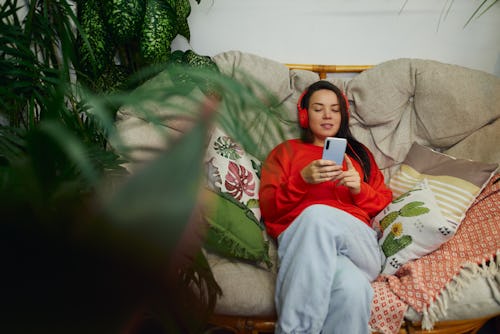Tech
How To Change The App Icons On Your iPhone
So aesthetic.

There’s no doubt that the aesthetics of the spaces you frequently occupy can have a strong effect on you. It’s the reason why many people brush up on feng shui fundamentals when moving into a new apartment, or have been playing de-clutter Tetris with perfecting their WFH office. But digital spaces can also impact one’s mood, productivity, and general mindset, too. (Case in point: The anxiety that comes with opening the fifteenth tab on your browser.) And what space is more frequented on your devices than your iPhone’s home screen? Maybe you’ve grouped together similar apps on your home screen, or Marie Kondo’ed those time-sucking apps, but have you ever considered changing the actual icons on your home screen? The same ol' boring icons don't have to be the same ol' boring thing any longer.
Not to knock the graphics presented by your most used apps or anything, but sometimes it's just more fun to DIY. With the use of some iOS features, as well as apps, you can customize app icons on your iPhone to reflect everything from personalized graphics to photos from your camera roll. Not only can you further advance your on-brand ~aesthetic~, but it will fill your home screen with images that conjure up positive emotions for you — or just add a bit of fun to your daily scrolling.
If you’re ready to have a home screen that screams “Graphic design is my passion,” here’s how to change the app icons on your iPhone’s home screen.
Apple Shortcuts
You might already know about the power of custom widgets, but did you know that you can also use a built-in Apple feature to create custom icons for your apps? Through an app called Shortcuts, which automatically comes preinstalled on your iPhone, you can easily create a custom Shortcut icon that functions in the same way that an app icon would.
Open Shortcuts, click the plus (+) icon in the top right corner of the app to add a new Shortcut, then click “Add Action.” Select “Scripting” from the menu, then select “Open App.” Click on the “App” portion of this text once it has loaded, then select the app you’d like to make a custom icon for. On the top left corner of the screen, you can then select its icon and customize its color and graphic in settings. You can’t add a custom photo, but you can choose fun emojis or coordinating colors.
Select the icon of a square with an upward-pointing arrow from the bottom tab, and select “Add to Home Screen.” Voila, you’ve just made a new icon. To rid the regular icon from your home screen, you can hold down on the app icon and select “Edit Home Screen,” then click “Remove from Home Screen. That way, you can use your customized Shortcuts icon in place of the old icon. (Just remember to rename it whatever the App’s name is.)
Iconical App
One app available to create custom icons for your apps is called Iconical. Available on the App Store for $2.99, Iconical supports 85,000 apps, which means you have a lot of art projects ahead of you. In a mere three steps, you'll have new home screen art. All you have to do is log in to Iconical, which will scan your phone for supported apps. Select which app you'd like to change the icon for, and then either download an image from the internet to represent it, or use the drawing tools to make up your own. That's it!
Apple Configurator 2
Your second option is a little bit more technologically advanced. Start by downloading the Apple Configurator 2. From there, create a profile. According to Gadget Hacks, you then need to create bookmarks, and choose images from your Mac to use as your iPhone apps icons. You'll just have to make sure that your chosen images are less than 1.4 MB. Then simply save your work and export.
Whichever path you take to icon graphic artistry will result in awe-inspiring home screens. Whoever catches a glimpse of your phone is going to want a piece of the DIY icon action. Because you are now not only an artist but a customizable phone genius, you'll be able to show others the way to making the most of their iPhone.
This article was originally published on